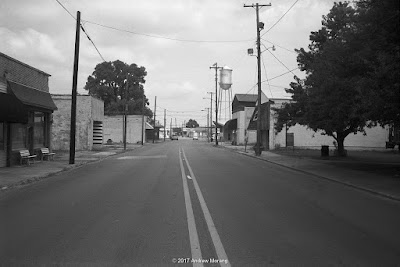 |
| North First Street or US. 287, McGehee, Arkansas. |
McGehee, a city in Desha County, is one of these agricultural and railroad junction towns in the Arkansas Delta. McGehee developed in the 1870s, when the railroad was cut through this area of undeveloped hardwood bottomlands and marshes. A sawmill was one of the first industries.
The rail lines, still active and an important commerce routing, are now operated by Union Pacific Railroad.
The Missouri-Pacific Depot was built in 1910, in a Mediterranean/Italianate style, combining Spanish tiles on the roof and exposed beams with a Craftsman appearance. The depot has been restored and is on the National Register of Historic Places. Hord Architects of Memphis, TN, and Miller-Newell Engineers restored the North Building of the McGehee Train Depot, with funding from the Arkansas Highway Transportation Department and local contributions. The south depot was restored in 2013 and now houses the World War II Japanese American Internment Museum. The internment camp was east of town. The site now is a grassy field with no remnants of the WWII barracks.
McGehee looks like many other delta towns: shuttered stores, almost empty streets, and a forlorn look.
First Street was once the commercial strip with sturdy early 20th century brick shops.
The old cinema is now the 2nd Chance Ministries. It's a sign of a town's decay when ministries occupy old theaters, schools, or auditoriums on otherwise deserted streets.
First Street was once the commercial strip with sturdy early 20th century brick shops.
The old cinema is now the 2nd Chance Ministries. It's a sign of a town's decay when ministries occupy old theaters, schools, or auditoriums on otherwise deserted streets.
These photographs are an experiment with a 1970s Olympus Trip 35 camera with a fixed 40mm f/2.8 lens. This compact camera was sold in the millions and has become somewhat of a cult item among recent film users. The lens is a 4-element 3-group design, which likely means a Tessar-type optic. Tessars are noted for sharpness with a type of edge enhancement that make transitions look crisp. I can confirm that this Olympus lens is excellent. The film was the Kodak BW400CN C41-type black and white film, which is rather grainy. I used a yellow filter to enhance the sky. This BW is very forgiving on exposure but never quite has the tonality of traditional film. Next time, I will experiment with a finer-grain traditional B&W film.








No comments:
Post a Comment